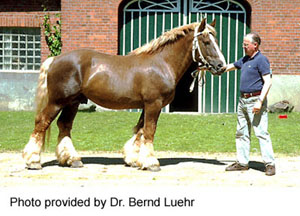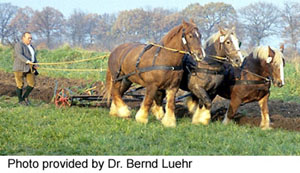

Schleswig


Introduction: If you have any comments or suggestions, please click here.
Names: Schleswig, Schleswig Heavy Draft, Schleswiger Heavy Draft. I will use the shortest name!
Origin: Comes from northern Germany. In the northwest (of Germany), the Schleswig is very similar to the Jutlands of Denmark. According to one source, the breeding areas and studs are Denmark and Germany--specifically, Jutland and North and South Schleswig--and breeding is entirely in the hands of farmers, both in Denmark and Germany. (Would this imply that the Schleswig is the German variation of the Danish Jutland? How would this affect/compare to the idea mentioned on the Frederiksborg page about the connection between the Frederiksborg and the Jutland?)
Breeding: They
possess a percentage of Thoroughbred
blood. At one point, the
breed seemed in danger of dying out, but in the last thirty years (approximately
1940-1970) it has increased again.
The breed is native to Schleswig, north of the Eider.
Originally it contained Thoroughbred
and warm-blood lines. Later
development was due in 1860 to a Suffolk Punch
stallion, Oppenheim LXII; in 1938 Jutland
blood was introduced.
Description: Heavy, cobby, low-to-the-ground conformation. Overall a rather compact, stocky horse packed with power and with a fine back-line.
Action: Striding, free, brisk walk; energetic action in trot.
Body: Neck inclined to be short and rather heavy. Broad chest with plenty of depth in the girth. Strong back, not too long. Well-muscled shoulders. Good barrel. Broad, muscular loins. Quarters broad and rounded with well set-on tail. Strong, short limbs, often with forelegs set slightly wide apart.
Color: Mostly chestnut in all shades; seldom grey and bay.
Head: Short with broad forehead.
Hooves: Large, round, often rather flat.
Legs: Strong, short limbs, often with forelegs set slightly wide apart. Not much feather at fetlocks.
Size: 15.2-16 hands. 15.2 to 16.2 hands.
Temperament: Lively and willing. In general, docile and good-natured.
Features: Strong, medium-sized, not too heavy work horse with stamina. Satisfactory trotting ability.
Uses: Once used to carry knights in armor. Now used mostly on farms, and for hauling.
Accomplishments:
Curiosities:
Profiles:
Conclusion: